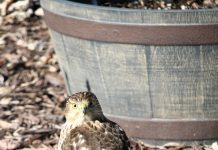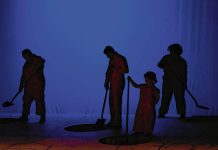Much can change in a matter of weeks, for humans and animals alike.
And in Paula Bandos’ third-grade class at Southside Elementary School, students are witnessing the various phases of life through the eyes of a butterfly.
As part of a science-turned technology-turned life lesson, Bandos’ students are raising monarch butterflies in their classroom.
The butterflies arrived in the classroom as tiny eggs and now live in specially designed mesh cages as they develop through the four stages of monarch life: egg, caterpillar, chrysalis and butterfly.
“(The students) get to see the whole process,” Bandos said.
The project began when Bandos’ friend, Lisa Weisner — a Columbus resident who frequently finds butterflies around the city and raises them in her home — offered to donate her monarchs to the students.
“My kids loved watching them, and I had been looking for someone else to partner with,” Weisner said. “Paula and I ride bikes together and talk about monarchs, so she’s a good one to partner with.”
By now, the eggs Bandos first brought into her classroom are full-grown butterflies, fully developed and capable of living in the wild fields of Columbus.
But they didn’t arrive that way. In fact, when Bandos first brought the eggs into her classroom Aug. 5, you couldn’t even see them.
“We had to use a magnifying glass,” she said.
Throughout the course of two or three weeks, the students watched the eggs hatch into larvae — better known as caterpillars — and begin to eat milkweed, a plant found readily in Columbus.
“I have to go out and pick it myself,” Bandos said.
As the caterpillars eat and grow, they attach themselves to the walls of the cage and hang down in the shape of the letter J. The insects then begin to form a chrysalis.
“I like watching them make the chrysalis, because they wiggle around a lot,” third-grader Allison Penrod said.
Once the chrysalis is formed, the butterfly has officially entered its third stage of life and has begun the quintessential butterfly experience: metamorphosis.
Caterpillars will stay in the chrysalis anywhere from a week to two weeks, depending on the climate. But when they emerge, the caterpillars will be gone, and in their place are full-grown butterflies ready to spread their wings.
“I like metamorphosis, because they’re coming out of the chrysalis, and it’s fun to see the butterflies,” third-grader Zoie Paswater said.
Once all of the butterflies emerge from a chrysalis, Bandos and the students will release them back into the wild to their natural habitat.
The students’ study of the evolution of a butterfly isn’t limited to mere observation, though.
Bandos, as well as other third-grade teachers and teacher’s aides, have supplied the youngsters with articles, songs, coloring books and other learning tools to engage them in their study of the ever-changing life stages.
Students even put some ownership of learning on themselves by creating PowerPoint presentations detailing the various phases of life and other information related to monarchs.
“I love making the slides because we get to use technology,” third-grader Loy Bassett said. “Technology is the best.”
And it’s not just third-graders who are learning through the butterfly process, either.
Bandos said she’s previously given some of Weisner’s butterflies to her father and grandson to allow them to work with the creatures and see the science and art of their changing bodies for themselves.
“This is multi-age learning,” she said.
And while Bandos acknowledge that taking care of the insects — feeding them, cleaning their cages, etc. — is a lot of work, her love of teaching, coupled with her love of nature, make her efforts worthwhile.
“We’re doing integrated curriculum, and we’re doing something for the environment,” she said.
[sc:pullout-title pullout-title=”Stages of monarch life” ][sc:pullout-text-begin]
Egg: Eggs are the size of a pinhead of pencil tip, and are usually off-white or yellow
Larva: Also called a caterpillar. Larvae have three body parts – the head, the thorax and the abdomen
Pupa/chrysalis: A chrysalis is a silk mat where caterpillars hang upside down. A cocoon is not the same as a chrysalis, because a cocoon is not made from silk.
Adult butterfly: Male monarchs have black spots on their wings, while female monarchs do not. Adults will mate when they’re 3 to 8 days old.
source: monarchlab.org
[sc:pullout-text-end]




